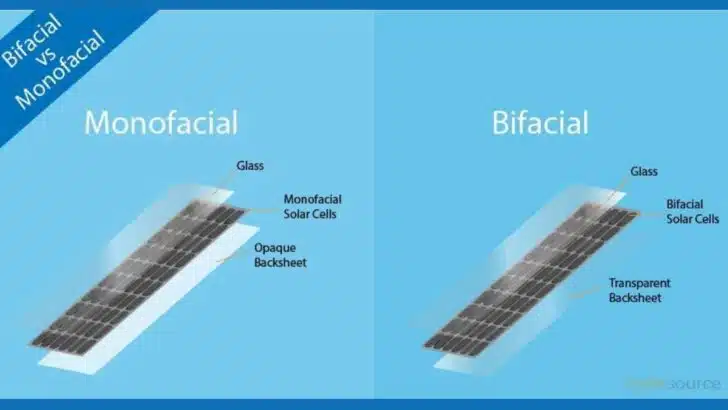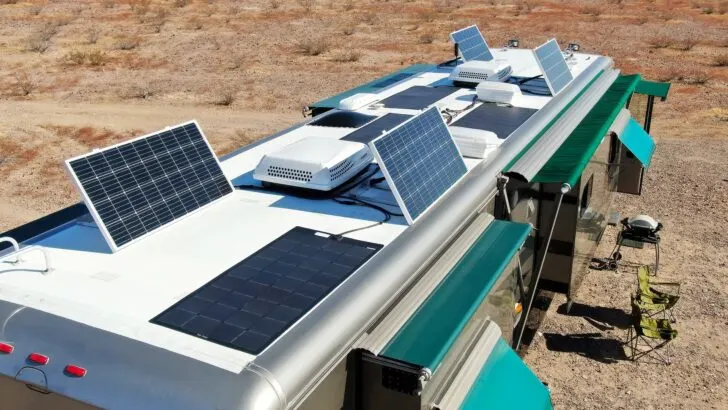Could bifacial solar panels be a game-changer for RVers? It’s possible, but there are a few things to consider on both sides of the pro/con equation.
In this post, we’re taking an in-depth look at the bifacial solar panel for RV solar systems. We’ll cover design, benefits, and drawbacks, how best to use them, and whether or not bifacial solar panels are likely to change the way RVs generate and use solar power.
What Are Bifacial Solar Panels?
If you’ve ever seen a traditional RV solar panel, you may have noticed that the back is a plain white material. This is called the “backsheet” and means there are solar cells on only one side of the panel, making it monofacial. With this design, it’s only capable of absorbing sunlight on one side.
A bifacial solar panel has a transparent backsheet, allowing it to collect light from two sides – both the front and the back. (The term “bifacial” essentially means “two-faced”.)

This illustration shows the difference in the construction of a monofacial vs a bifacial solar panel. (Photo source: Hyde Source)
So, a bifacial panel doesn’t have the white layer you typically see on the back of a monofacial panel. Instead, you’ll see the classic bluish-black cells with silvery connecting wires on both sides of the solar panel. This means the solar cells can collect light that hits the panel from the front/top and the back/bottom.
Bifacial panels are a considerable advancement in photovoltaic technology because, unlike traditional solar panels that offer energy generation from only the front side of the panel when it’s exposed to sunlight, bifacial panels can capture sunlight from both the front and back sides of the panel, offering more power generation from a single panel.
Bifacial solar panels are typically mounted on a raised structure or a reflective surface (like a white RV roof!) to optimize sunlight exposure on the rear side. They’re available in both framed and frameless designs, but the mounting system plays an important role in maximizing energy production by tilting and orienting the panels for optimal light capture.
Also, tilting is especially important for bifacial solar modules. This is because if they are mounted flat to the roof with little or no air/light gap underneath them, you’ll be losing out on the performance improvement they’re designed to provide by capturing reflected light off the roof. For more details, see our post Should I tilt my RV solar panels? You can also read about and see the tilted panels on our Newmar Mountain Aire in our post on our ultimate RV solar panel system.)

This solar array on the roof of our Newmar Mountain Aire uses both rigid and flexible panels. The rigid panels are mounted using SolaRVector lift/tilt kits. Tilting is even more important with bifacial solar panels.
What Are the Advantages of Bifacial Solar Panels for RVs?
The benefits of bifacial panels in a solar installation include:
Increased Efficiency
The primary advantage of bifacial panels is their ability to capture sunlight from multiple angles. This can produce up to 30% more energy compared to traditional monofacial solar panels, especially when used over a reflective surface such as a white RV roof.
Flexibility of Installation
Bifacial panels can be mounted vertically, horizontally, or at an angle, allowing RV owners to customize the setup based on available space. They also save space by offering the same power output in a smaller footprint.
Improved Performance In Low-Light/Shaded Conditions
When there’s shading/shadowing on an RV’s solar panels, bifacial models provide superior performance. That can be super helpful in treed or overcast situations. While output would, of course, be lower than in direct sunlight, it does provide the potential for more energy than monofacial panels in shaded or low-light conditions.
Warms Up & Sheds Snow More Quickly
The design of bifacial panels helps them warm up a bit faster, speeding up snow shedding. We know that snow isn’t likely the biggest concern for most RVers, but if you do RV in winter conditions, it’s something to consider.
What Are the Disadvantages of Bifacial Solar Panels for RVs?
Although bifacial panels offer several benefits when used on RVs, they have some drawbacks, too. Every RVer needs to weigh the advantages and disadvantages based on their needs.
Cost
Bifacial solar panels generally come with a higher upfront cost compared to traditional monofacial panels. However, this can be offset by their higher energy output.
Increased Maintenance
Unlike regular solar panels, bifacial models need to be kept clean on both sides. Of course, the underside of a solar panel won’t get dirty anywhere near as quickly as the top. But it is a consideration.
In addition to regular maintenance, it’s important that bifacial panels are properly installed to optimize output. They need to be mounted at the correct angle and orientation and need to be tilted for the best performance.
Space Requirements
Bifacial panels work best with more space around them to allow more light to reach the back. Of course, mounting panels with more space around them may limit the number of panels you can install in a given roof area. If things are already tight up there, this is another factor to consider since packing panels too close together can reduce the benefit of bifacial technology.
Potential Compatibility Issues
Bifacial solar panels are compatible with most RV solar power systems. However, it’s important to be sure that the existing charge controllers and inverters can accommodate them. It’s possible that upgrading other components might be needed to take full advantage of bifacial tech.
Bifacial Solar Panels For Use on RVs
Several companies manufacture bifacial solar panels. The following are three options that can be used on RVs.
Renogy Bifacial 115 Watt 12-Volt Solar Panel
These are rigid, high-efficiency monocrystalline panels that incorporate PERC (Passivated Emitter and Rear Contact) technology to maximize energy output even when they’re partially shaded, while also protecting the solar cells from overheating. PERC solar cells are modified conventional cells that give them the ability to produce 6% to 12% more energy than conventional solar panels.
These panels are IP68 waterproof, offer more than 80% output at 25 years, and come with a 10-year warranty.
- 【Bifacial Energy Yield up to 30%】 With the ability to capture sunlight from both sides, this 115 watt bifacial solar panel can provide up to 30%...
- 【More energy even in partially shaded】 With its innovative design that incorporates PERC, half-cut cell, bypass diodes, and 10 busbar...
Renogy Bifacial 450 Watt 12/24-Volt Solar Panels (2)
This is a set of two monocrystalline bifacial solar panels from Renogy totaling 900 watts. Like the smaller Renogy panels above, they’re also IP68 waterproof and use PERC technology for improved energy output and solar cell protection. They come with a 25-year warranty.
- 【Bifacial energy yield up to 30%】 With the ability to capture sunlight from both sides, this panel can provide up to 30% more energy compared to...
- 【More energy even in partially shaded】 With its innovative design that incorporates PERC, half-cut cell, bypass diodes, and 10 busbar...
BougeRV Bifacial 100 Watts 12-Volt 9BB Cell Mono Solar Panel
This bifacial monocrystalline solar panel from BougeRV is made with Class A solar cells and features a black corrosion-resistant aluminum frame. BougeRV offers an 18-month product warranty, as well as a 25-year power warranty.
- Increases the solar output by 30%. Instead of having an opaque back, BougeRV bifacial solar panels feature a transparent backside, allowing it to...
- Don't need to point to the sun and can be placed in every position. Since the sun is always moving throughout the day, it may need to be adjusted,...
To achieve the ideal output with their bifacial solar panels, BougeRV suggests using tilt mount brackets.
- 【MORE SUNLIGHT, MORE OUTPUT】Tilting design will get up to 50% more solar energy collection compared to horizontally mounted panels, which helps...
- 【SUITABLE ROOF】Adjustable solar panel mounting bracket is supported by most brands of solar panels, designed for off-grid solar systems and the...
We installed SolarVector Tilt Kits with monofacial panels when we upgraded our Mountain Aire’s solar array and they should work well with bifacial panels, making them so much easier to tilt.
Bifacial solar panels offer an advancement in solar energy tech, giving RV owners an improved way to harness the power of the sun. With their ability to capture light from both sides, they provide increased energy production and a step forward in sustainable RV living and extended boondocking.
Free RVing Tips, Tricks, Reviews & Giveaways
As 20-year full-timers, we share everything we’ve learned about RVing over the years. Join our online community to receive a wealth of great RVing knowledge delivered daily to your inbox.
Whether you’re a new RVer or a seasoned full-timer, you’ll love the wide range of RVing topics we cover. Don’t miss a single article or any of our famous Giveaways. Subscribe to our newsletter today!






Bill Chambers
Friday 2nd of February 2024
How about news on your new RV & truck? Why did you get rid of your Motorhome?
How about an article on how to clean your fresh water tank?
Love your articles,
Bill Chambers